Effects of Hierarchical City Centers on the Intensity and Direction of Urban Land Expansion: A Case Study of Beijing
Abstract
1. Introduction
2. Background and Analytical Framework
3. Research Area, Data, and Methods
3.1. Research Area
3.2. Data
3.3. Methods
3.3.1. Analysis of Multi-Ring Buffer Zones
3.3.2. Urban Land Expansion Intensity
3.3.3. Urban Land Expansion Direction
4. Results
4.1. Administrative Centers and Intensity of Urban Land Expansion
4.1.1. Effect of Municipal Center
4.1.2. Effect of District or County Centers
4.2. Administrative Centers and the Direction of Urban Land Expansion
4.3. Expansion Mode of Urban Land in the Suburb of Mega-Cities
5. Conclusions and Discussion
Author Contributions
Funding
Conflicts of Interest
References
- Hortas-Rico, M.; Sole-Olle, A. Does urban sprawl increase the costs of providing local public services? Evidence from spanish municipalities. Urban Stud. 2010, 47, 1513–1540. [Google Scholar] [CrossRef]
- Vasanen, A. Functional polycentricity: Examining metropolitan spatial structure through the connectivity of urban sub-centres. Urban Stud. 2012, 49, 3627–3644. [Google Scholar] [CrossRef]
- Salvati, L.; Zambon, I.; Chelli, F.M.; Serra, P. Do spatial patterns of urbanization and land consumption reflect different socioeconomic contexts in Europe? Sci. Total Environ. 2018, 625, 722–730. [Google Scholar] [CrossRef] [PubMed]
- Sýkora, L.; Stanilov, K. The challenge of postsocialist suburbanization. In Confronting Suburbanization: Urban Decentralization in Postsocialist Central and Eastern Europe; Sýkora, L., Stanilov, K., Eds.; Wiley & Sons: Hoboken, NJ, USA, 2014; pp. 1–32. [Google Scholar]
- Garcia-López, M.-À.; Muñiz, I. Employment decentralisation: Polycentricity or scatteration? The case of Barcelona. Urban Stud. 2010, 47, 3035–3056. [Google Scholar] [CrossRef]
- Veneri, P. The identification of sub-centres in two Italian metropolitan areas: A functional approach. Cities 2013, 31, 177–185. [Google Scholar] [CrossRef]
- Fernandez-Maldonado, A.M.; Romein, A.; Verkoren, O.; Paula Pessoa, R.P. Polycentric structures in latin american metropolitan areas: Identifying employment sub-centres. Reg. Stud. 2014, 48, 1954–1971. [Google Scholar] [CrossRef]
- Aguilar, A.G.; Hernandez, J. Metropolitan change and uneven distribution of urban sub-centres in Mexico City, 1989–2009. Bull. Lat. Am. Res. 2016, 35, 191–209. [Google Scholar] [CrossRef]
- Angel, S.; Blei, A.M. The spatial structure of American cities: The great majority of workplaces are no longer in CBDs, employment sub-centers, or live-work communities. Cities 2016, 51, 21–35. [Google Scholar] [CrossRef]
- Carruthers, J.I.; Ulfarsson, G.F. Urban sprawl and the cost of public services. Environ. Plan. B Plan. Des. 2003, 30, 503–522. [Google Scholar] [CrossRef]
- Haase, D.; Kabisch, N.; Haase, A. Endless urban growth? On the mismatch of population, household and urban land area growth and its effects on the urban debate. PLoS ONE 2013, 8, e66531. [Google Scholar] [CrossRef]
- Ermini, B.; Santolini, R. Urban sprawl and property tax of a city’s core and suburbs: Evidence from Italy. Reg. Stud. 2017, 51, 1374–1386. [Google Scholar] [CrossRef]
- Firman, T.; Fahmi, F.Z. The Privatization of metropolitan Jakarta’s (Jabodetabek) urban fringes: The early stages of “post-suburbanization” in Indonesia. J. Am. Plan. Assoc. 2017, 83, 68–79. [Google Scholar] [CrossRef]
- Seto, K.C.; Fragkias, M.; Gueneralp, B.; Reilly, M.K. A meta-analysis of global urban land expansion. PLoS ONE 2011, 6, e23777. [Google Scholar] [CrossRef] [PubMed]
- Martellozzo, F.; Amato, F.; Murgante, B.; Clarke, K.C. Modelling the impact of urban growth on agriculture and natural land in Italy to 2030. Appl. Geogr. 2018, 91, 156–167. [Google Scholar] [CrossRef]
- Sturck, J.; Levers, C.; van der Zanden, E.H.; Schulp, C.J.E.; Verkerk, P.J.; Kuemmerle, T.; Helming, J.; Lotze-Campen, H.; Tabeau, A.; Popp, A.; et al. Simulating and delineating future land change trajectories across Europe. Reg. Environ. Chang. 2018, 18, 733–749. [Google Scholar] [CrossRef]
- Tomaszewska, M.; Henebry, G.M. Urban-rural contrasts in central-eastern european cities using a MODIS 4 micron time series. Remote Sens. 2016, 8, 924. [Google Scholar] [CrossRef]
- Cheng, H.; Liu, Y.; He, S.; Shaw, D. From development zones to edge urban areas in China: A case study of Nansha, Guangzhou City. Cities 2017, 71, 110–122. [Google Scholar] [CrossRef]
- Heffner, K.; Gibas, P. Functional areas in the regions and their links to scope sub-regional centres impact. Stud. Reg. 2016, 46, 27–39. [Google Scholar] [CrossRef]
- Ding, C.R. Urban spatial development in the land policy reform era: Evidence from Beijing. Urban Stud. 2004, 41, 1889–1907. [Google Scholar] [CrossRef]
- Zheng, S.; Kahn, M.E. Land and residential property markets in a booming economy: New evidence from Beijing. J. Urban Econ. 2008, 63, 743–757. [Google Scholar] [CrossRef]
- Huang, D.; Liu, Z.; Zhao, X. Monocentric or polycentric? The urban spatial structure of employment in Beijing. Sustainability 2015, 7, 11632–11656. [Google Scholar] [CrossRef]
- Huang, D.; Liu, Z.; Zhao, X.; Zhao, P. Emerging polycentric megacity in China: An examination of employment subcenters and their influence on population distribution in Beijing. Cities 2017, 69, 36–45. [Google Scholar] [CrossRef]
- Wu, F. Adding new narratives to the urban imagination: An introduction to ‘New directions of urban studies in China’. Urban Stud. 2020, 57, 459–472. [Google Scholar] [CrossRef]
- Deng, F.F.; Huang, Y.Q. Uneven land reform and urban sprawl in China: The case of Beijing. Prog. Plan. 2004, 61, 211–236. [Google Scholar] [CrossRef]
- Hudecek, T.; Hnilicka, P.; Dlouhy, M.; Leno Cutakova, L.; Leno, M. Urban structures, population density and municipal expenditures: An empirical study in the Czech Republic. Urban Stud. 2019, 56, 3450–3465. [Google Scholar] [CrossRef]
- Kukulska-Koziel, A.; Szylar, M.; Cegielska, K.; Noszczyk, T.; Hernik, J.; Gawronski, K.; Dixon-Gough, R.; Jombach, S.; Valanszki, I.; Kovacs, K.F. Towards three decades of spatial development transformation in two contrasting post-Soviet cities-Krakow and Budapest. Land Use Policy 2019, 85, 328–339. [Google Scholar] [CrossRef]
- Burian, J.; Macku, K.; Zimmermannova, J.; Netek, R. Sustainable spatial and temporal development of land prices: A case study of Czech cities. ISPRS Int. J. Geo Inf. 2020, 9, 396. [Google Scholar] [CrossRef]
- Liu, X.; Wang, M. How polycentric is urban China and why? A case study of 318 cities. Landsc. Urban Plan. 2016, 151, 10–20. [Google Scholar] [CrossRef]
- Giuliano, G.; Small, K.A. Subcenters in the Los Angeles region. Reg. Sci. Urban Econ. 1991, 21, 163–182. [Google Scholar] [CrossRef]
- McDonald, J.F.; Prather, P.J. Suburban employment centres: The case of Chicago. Urban Stud. 1994, 31, 201–218. [Google Scholar] [CrossRef]
- Anas, A.; Arnott, R.; Small, K.A. Urban spatial structure. J. Econ. Lit. 1998, 36, 1426–1464. [Google Scholar]
- Hu, L.; Sun, T.; Wang, L. Evolving urban spatial structure and commuting patterns: A case study of Beijing, China. Transp. Res. Part D Transp. Environ. 2018, 59, 11–22. [Google Scholar] [CrossRef]
- O’Sullivan, A. Urban Economics, 7th ed.; The McGraw-Hill Companies, Inc.: New York, NY, USA, 2009. [Google Scholar]
- McDonald, J.F. The identification of urban employment subcenters. J. Urban Econ. 1987, 21, 242–258. [Google Scholar] [CrossRef]
- Heikkila, E.; Gordon, P.; Kim, J.I.; Peiser, R.B.; Richardson, H.W.; Dale-Johnson, D. What happened to the CBD-distance gradient? Land values in a policentric city. Environ. Plan. A 1989, 21, 221–232. [Google Scholar] [CrossRef]
- Ma, L.J.C. Urban administrative restructuring, changing scale relations and local economic development in China. Political Geogr. 2005, 24, 477–497. [Google Scholar] [CrossRef]
- Li, H.; Wei, Y.D.; Liao, F.H.; Huang, Z. Administrative hierarchy and urban land expansion in transitional China. Appl. Geogr. 2015, 56, 177–186. [Google Scholar] [CrossRef]
- Wang, C.; Liu, H.; Zhang, M. The influence of administrative boundary on the spatial expansion of urban land: A case study of Beijing-Tianjin-Hebei urban agglomeration. Geogr. Res. 2016, 35, 173–183. [Google Scholar]
- Tiebout, C.M. A pure theory of local expenditures. J. Political Econ. 1956, 64, 416–424. [Google Scholar] [CrossRef]
- Bardhan, P. Decentralization of governance and development. J. Econ. Perspect. 2002, 16, 185–205. [Google Scholar] [CrossRef]
- Lin, Y.; Liu, Z. China’s fiscal decentralization and economic growth. J. Peking Univ. (Hum. Soc. Sci.) 2000, 5, 5–17. [Google Scholar]
- Jin, H.H.; Qian, Y.Y.; Weingast, B.R. Regional decentralization and fiscal incentives: Federalism, Chinese style. J. Publ. Econ. 2005, 89, 1719–1742. [Google Scholar] [CrossRef]
- Xu, C. The fundamental institutions of China’s reforms and development. J. Econ. Lit. 2011, 49, 1076–1151. [Google Scholar] [CrossRef]
- Oi, J.C. Fiscal reform and the economic foundations of local state corporatism in China. World Politics 1992, 45, 99–126. [Google Scholar] [CrossRef]
- Hsing, Y.-T. Land and territorial politics in urban China. China Quart. 2006, 187, 575–591. [Google Scholar] [CrossRef]
- NPC. The National People’s Congress, Land Administration Law. Available online: http://f.mnr.gov.cn/201909/t20190906_2464343.html (accessed on 2 September 2020).
- NPC. The National People’s Congress, Urban Real Estate Administration Law. Available online: http://www.npc.gov.cn/npc/c30834/201909/54daabc2a4014a3f8d3097bfaaf88f96.shtml (accessed on 2 September 2020).
- Huang, D.; Huang, Y.; Zhao, X.; Liu, Z. How do differences in land ownership types in China affect land development? A case from Beijing. Sustainability 2017, 9, 123. [Google Scholar] [CrossRef]
- Cao, G.; Feng, C.; Tao, R. Local “land finance” in China’s urban expansion: Challenges and solutions. China World Econ. 2008, 16, 19–30. [Google Scholar] [CrossRef]
- Wang, J.; He, C. Chinese urban land expansion issues in transition period: Empirical test based on muth-mill model. Urban Stud. 2009, 41, 24–30. [Google Scholar]
- Sun, X.; Zhou, F. Land finance and the tax-sharing system: An empirical interpretation. Soc. Sci. China 2014, 35, 47–64. [Google Scholar]
- Lichtenberg, E.; Ding, C. Local officials as land developers: Urban spatial expansion in China. J. Urban Econ. 2009, 66, 57–64. [Google Scholar] [CrossRef]
- He, C.; Zhou, Y.; Huang, Z. Fiscal decentralization, political centralization, and land urbanization in China. Urban Geogr. 2016, 37, 436–457. [Google Scholar] [CrossRef]
- Wang, J.; Lin, Y.; Glendinning, A.; Xu, Y. Land-use changes and land policies evolution in China’s urbanization processes. Land Use Policy 2018, 75, 375–387. [Google Scholar] [CrossRef]
- Yang, F. Local government and local town dev elopment. City Plan. Rev. 2003, 32, 19–23. [Google Scholar]
- Chen, Y.; Li, H.; Zhou, L.-A. Relative performance evaluation and the turnover of provincial leaders in China. Econ. Lett. 2005, 88, 421–425. [Google Scholar] [CrossRef]
- Blanchard, O.; Shleifer, A. Federalism with and without political centralization: China versus Russia. IMF Staff Pap. 2001, 48, 171–179. [Google Scholar]
- Xue, H.; Shi, X.; Tang, P. The impact of chinese decentralization on the deviation of land granting prices. Res. Sci. 2013, 35, 1134–1142. [Google Scholar]
- Zhang, L.; Wang, X.; Xu, X. Fiscal incentive, political incentive and local officials’ land supply. China Ind. Econ. 2011, 116, 35–43. [Google Scholar]
- Liu, J. China’s administrative division evolution. Science 1992, 17, 38–41. [Google Scholar]
- Wei, H. Administrative hierarchy and growth of city scale in China. Urban. Environ. Stud. 2014, 1, 4–17. (In Chinese) [Google Scholar]
- Zhang, J.; Cui, Y. Spatial and scale characteristics of administrative center in America and its cause of formation. Econ. Geogr. 2011, 31, 477–497. [Google Scholar]
- Ades, A.F.; Glaeser, E.L. Trade and circuses-explaining urban giants. Quart. J. Econ. 1995, 110, 195–227. [Google Scholar] [CrossRef]
- Moomaw, R.L.; Shatter, A.M. Urbanization and economic development: A bias toward large cities? J. Urban. Econ. 1996, 40, 13–37. [Google Scholar] [CrossRef] [PubMed]
- Wang, S. Soft power: A study on Beijing’s comparative advantage in economic development. J. Beijing Adm. Coll. 2007, 21, 57–61. [Google Scholar]
- Xiang, K.; Jiang, L. The open-oriented pattern of contemporary administrative centerconstruction: The critically research of contemporary administrative center. Urban. Stud. 2005, 12, 17–22. [Google Scholar]
- Lv, X.; Huang, X. Research progress and prospect of construction land expansion. Geogr. Geo Inf. Sci. 2013, 29, 51–58. [Google Scholar]
- Hu, D.; Liu, J. The relationship between administrative hierarchy, power and regional economy: The spatial process of Chinese government power and its influence. Chin. Publ. Adm. 2007, 135, 11–13. [Google Scholar]
- Zhu, J.; Hu, T. Disordered land-rent competition in China’s periurbanization: Case study of Beijing Township, Beijing. Environ. Plan. A Econ. Space 2009, 41, 1629–1646. [Google Scholar] [CrossRef]
- Kuang, W. Spatio-temporal patterns of intra-urban land use change in Beijing, China between 1984 and 2008. Chin. Geogr. Sci. 2012, 22, 210–220. [Google Scholar] [CrossRef]
- Huang, D.; Jin, H.; Zhao, X.; Liu, S. Factors influencing the conversion of arable land to urban use and policy implications in Beijing, China. Sustainability 2015, 7, 180–194. [Google Scholar] [CrossRef]
- Liu, S.W.; Chuanjun, S.; Hongquan, A. GIS based model of urban land use growth in Beijing. Acta Geogr. Sin. 2000, 55, 407. [Google Scholar]
- Zhao, S.; Zhou, D.; Zhu, C.; Qu, W.; Zhao, J.; Sun, Y.; Huang, D.; Wu, W.; Liu, S. Rates and patterns of urban expansion in China’s 32 major cities over the past three decades. Landsc. Ecol. 2015, 30, 1541–1559. [Google Scholar] [CrossRef]

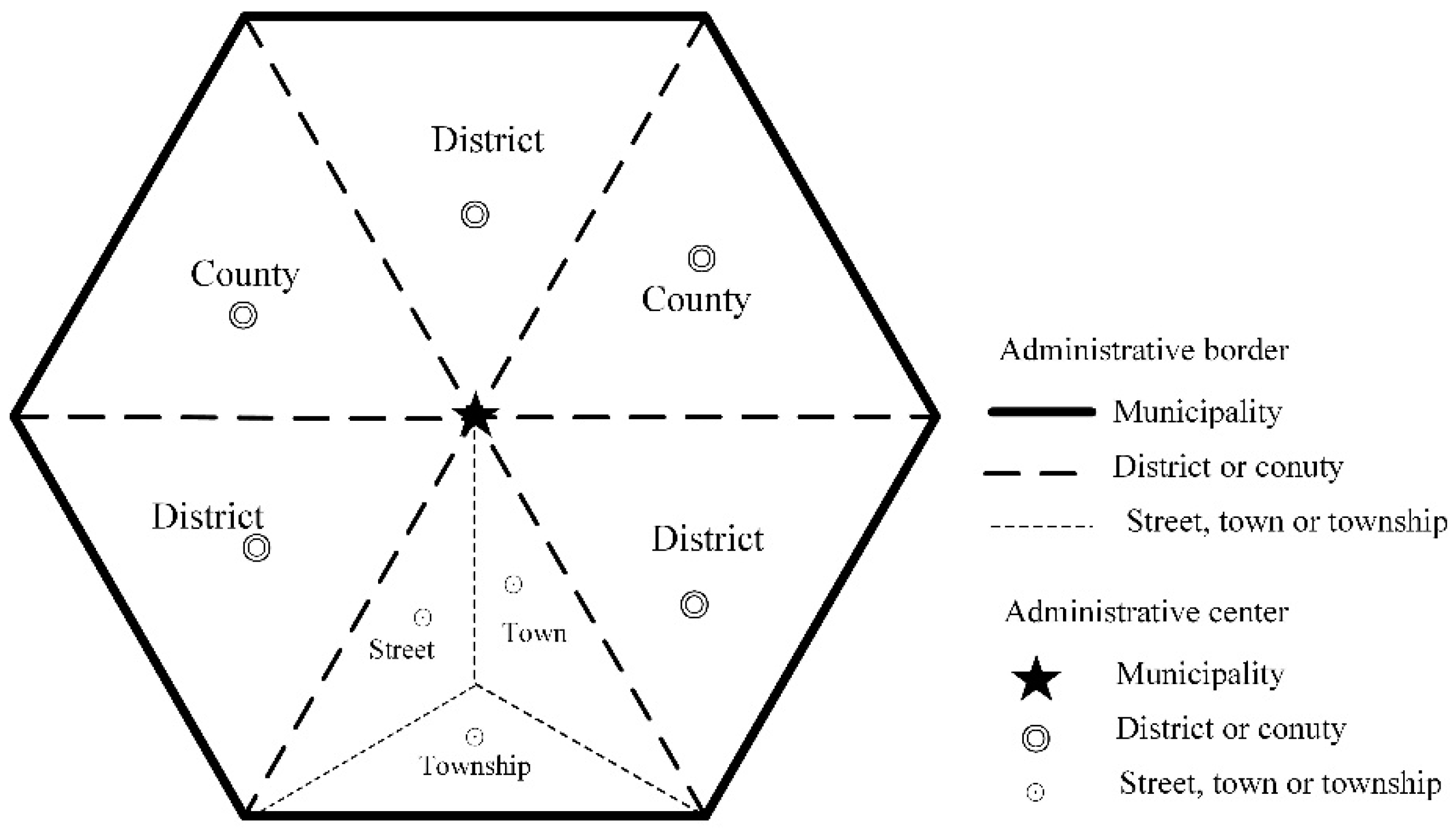
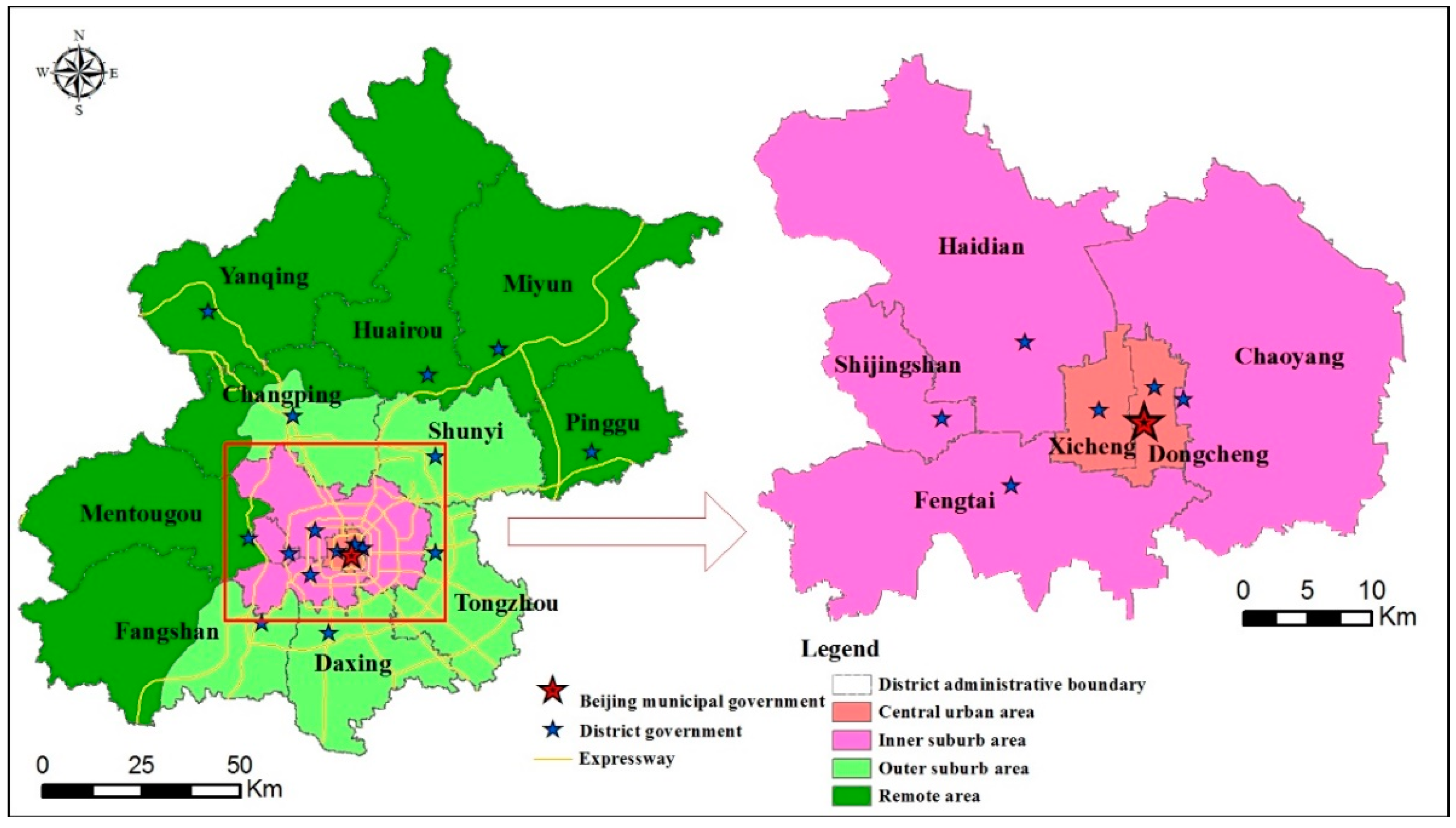
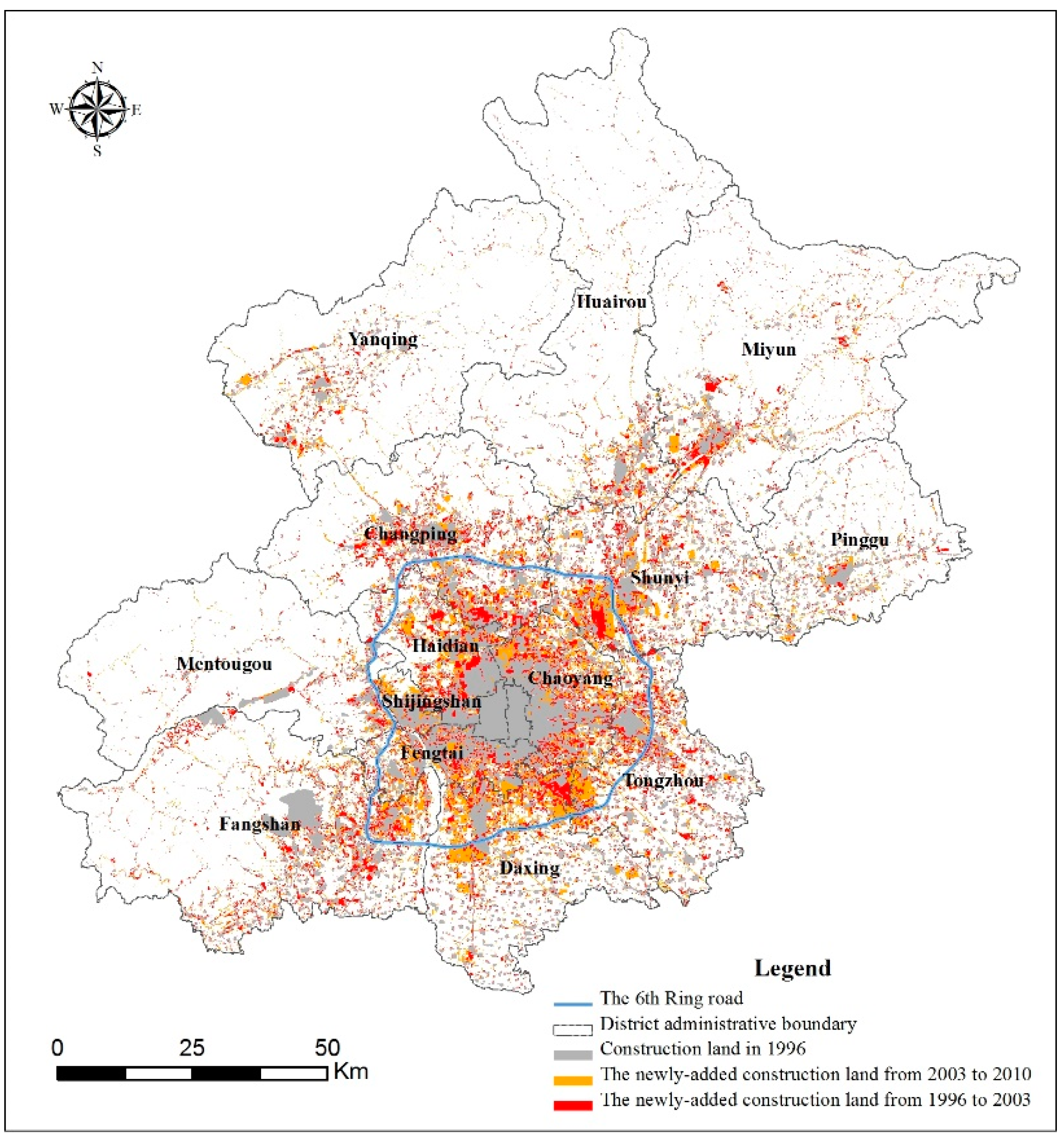
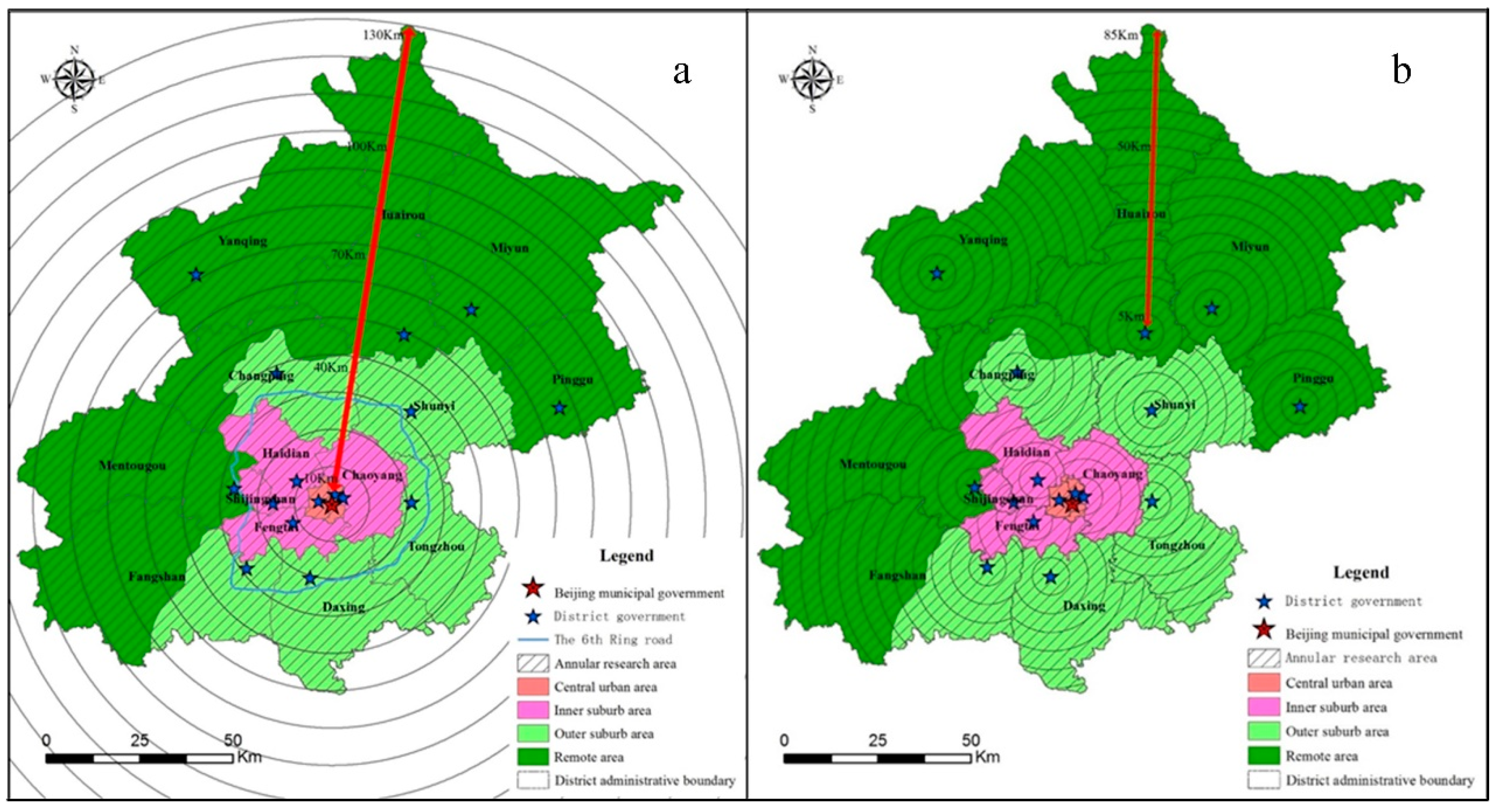
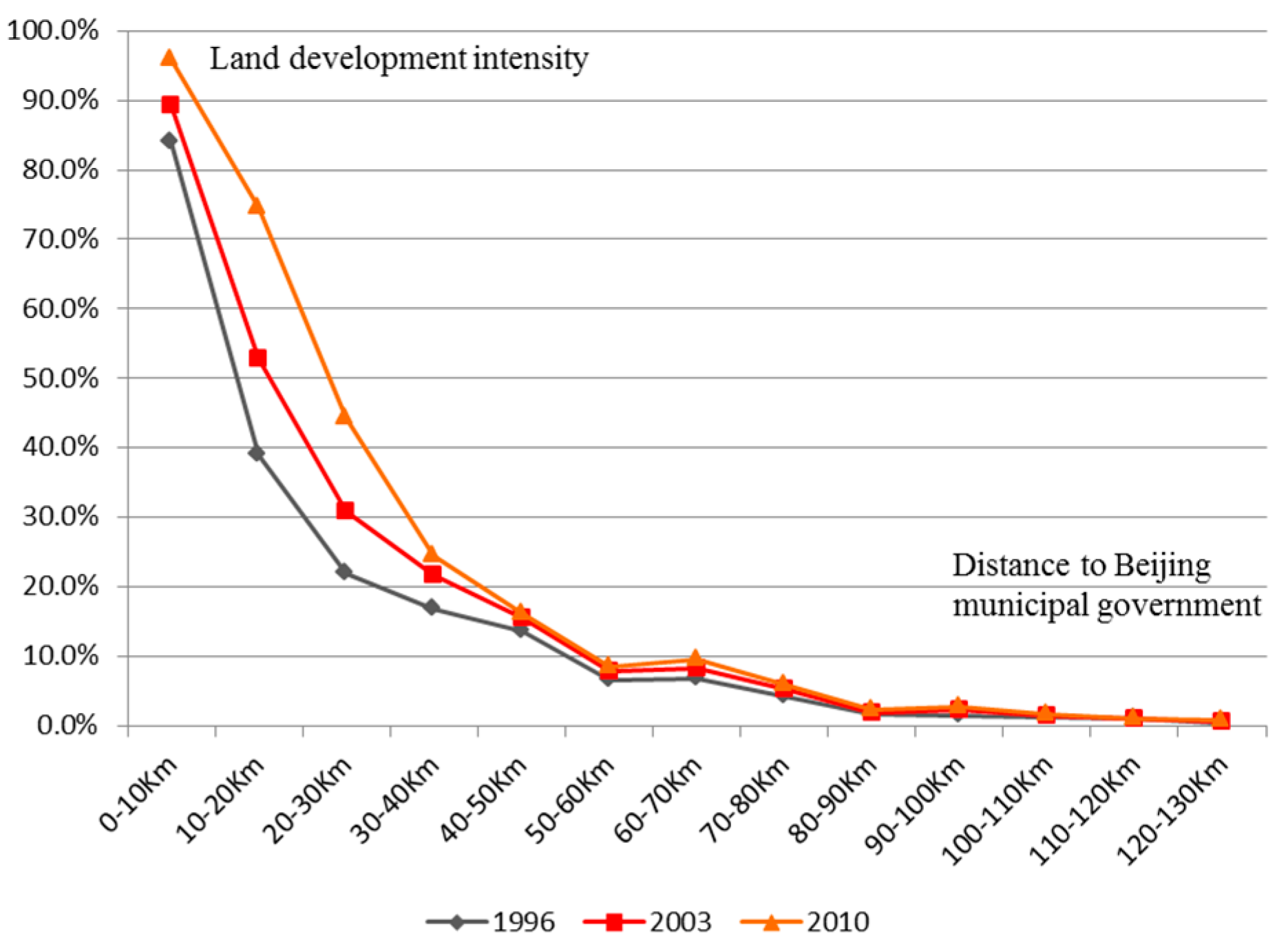
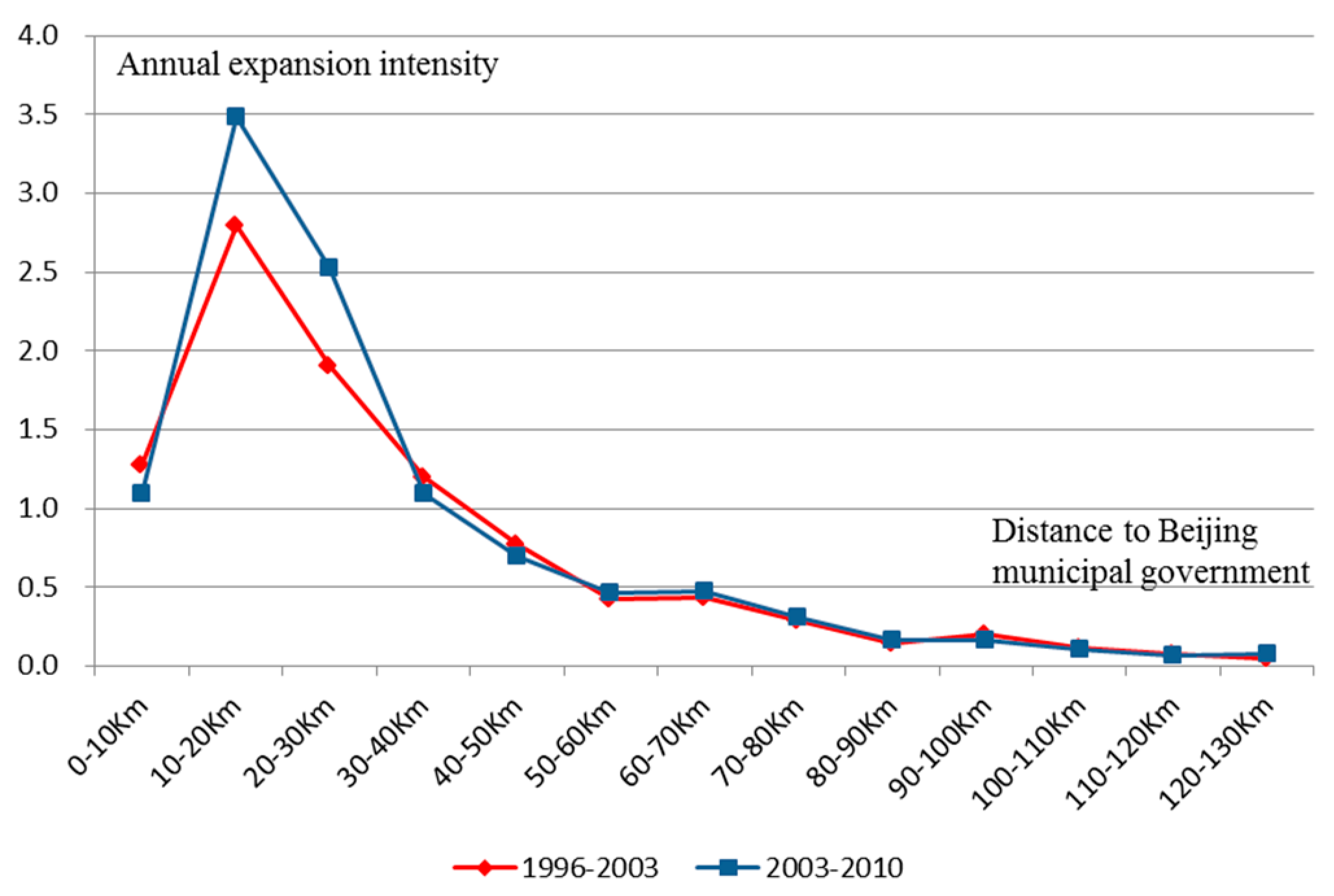
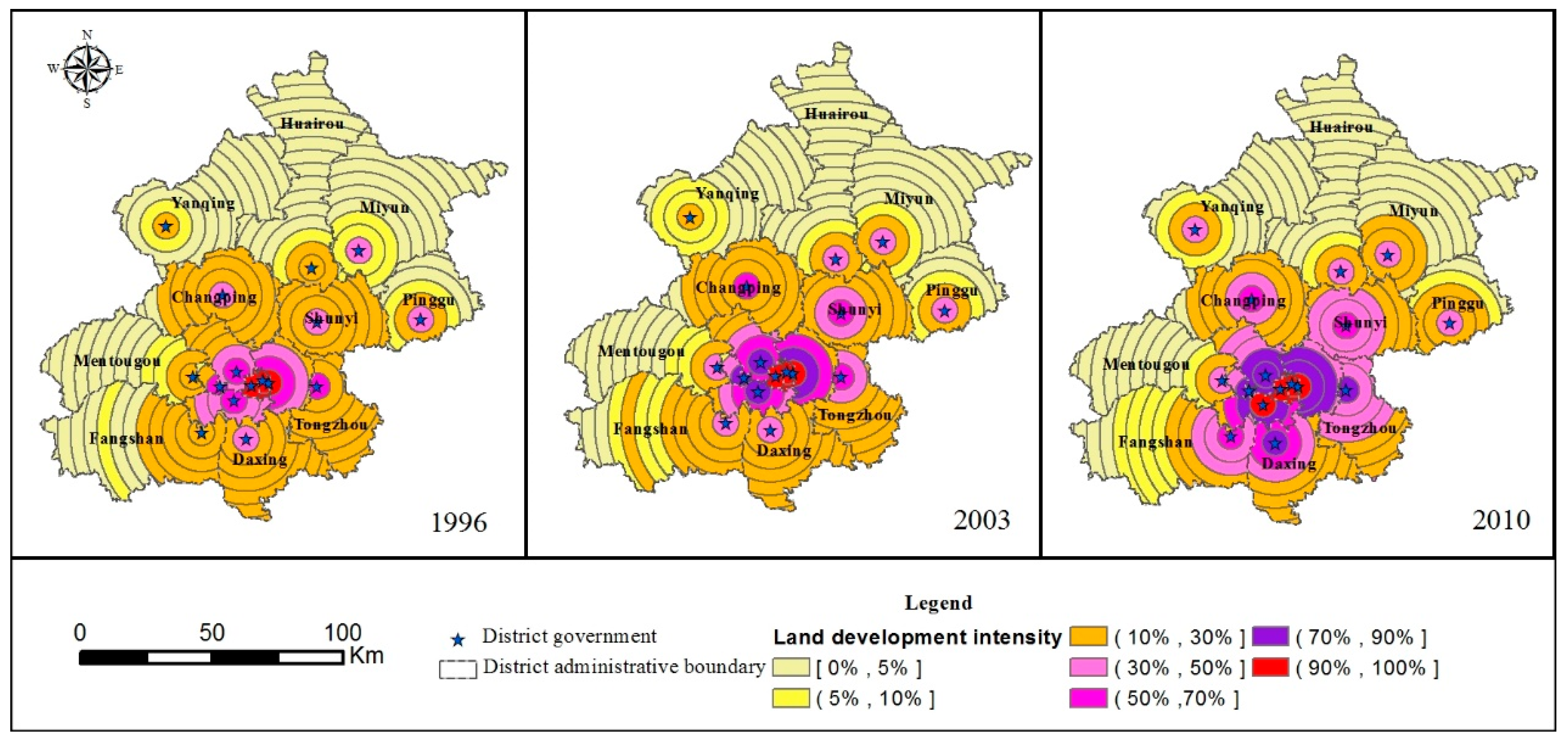


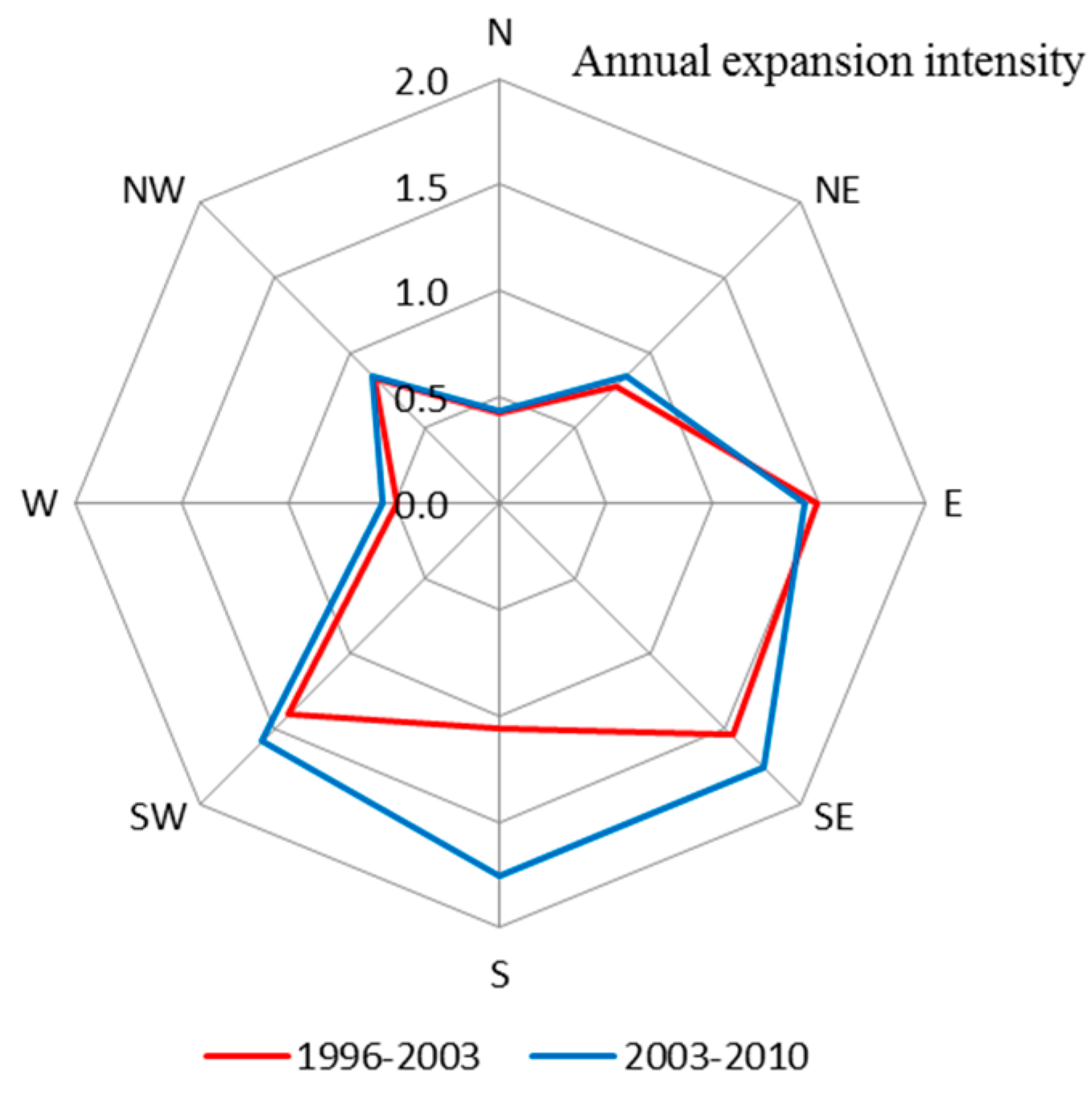

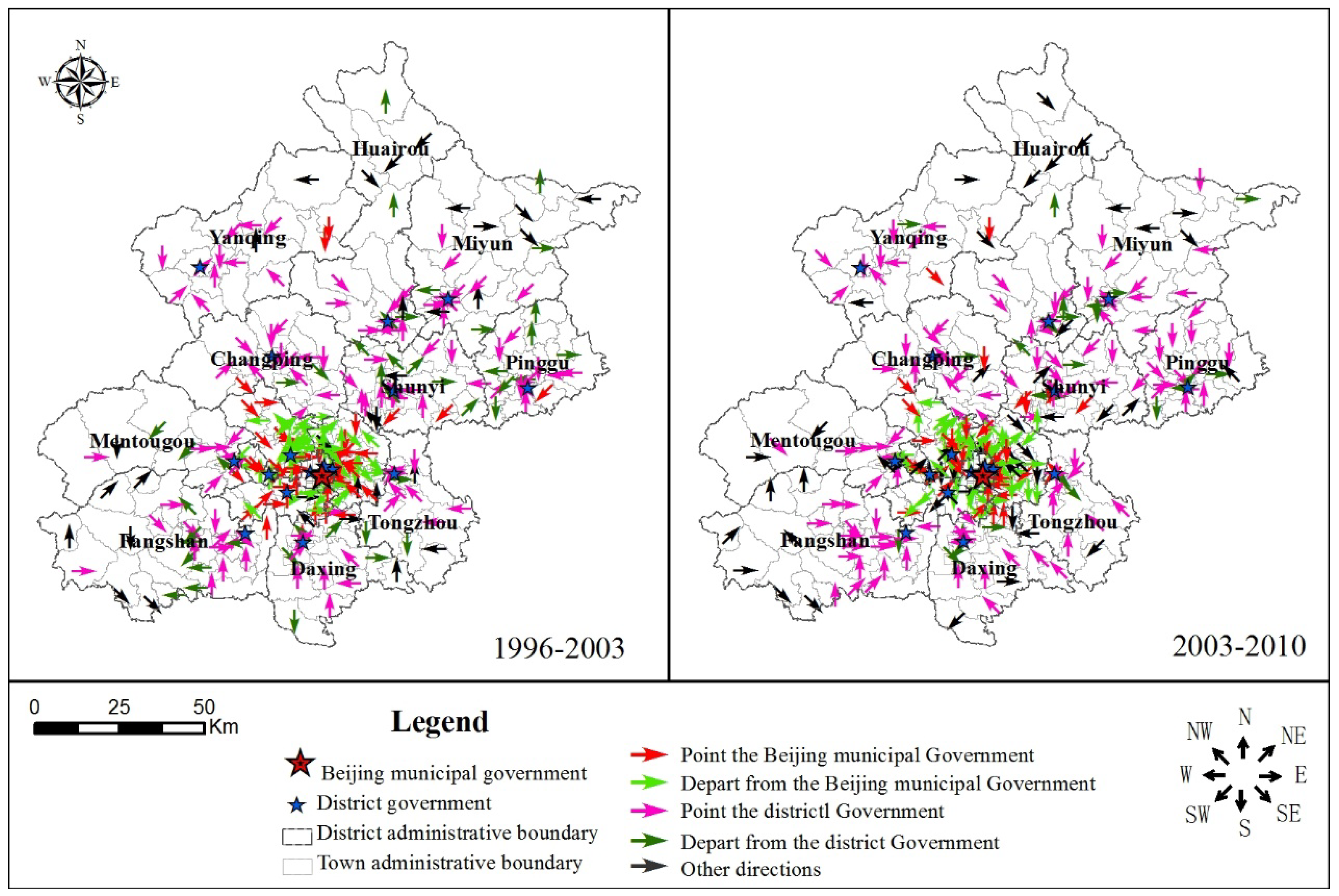
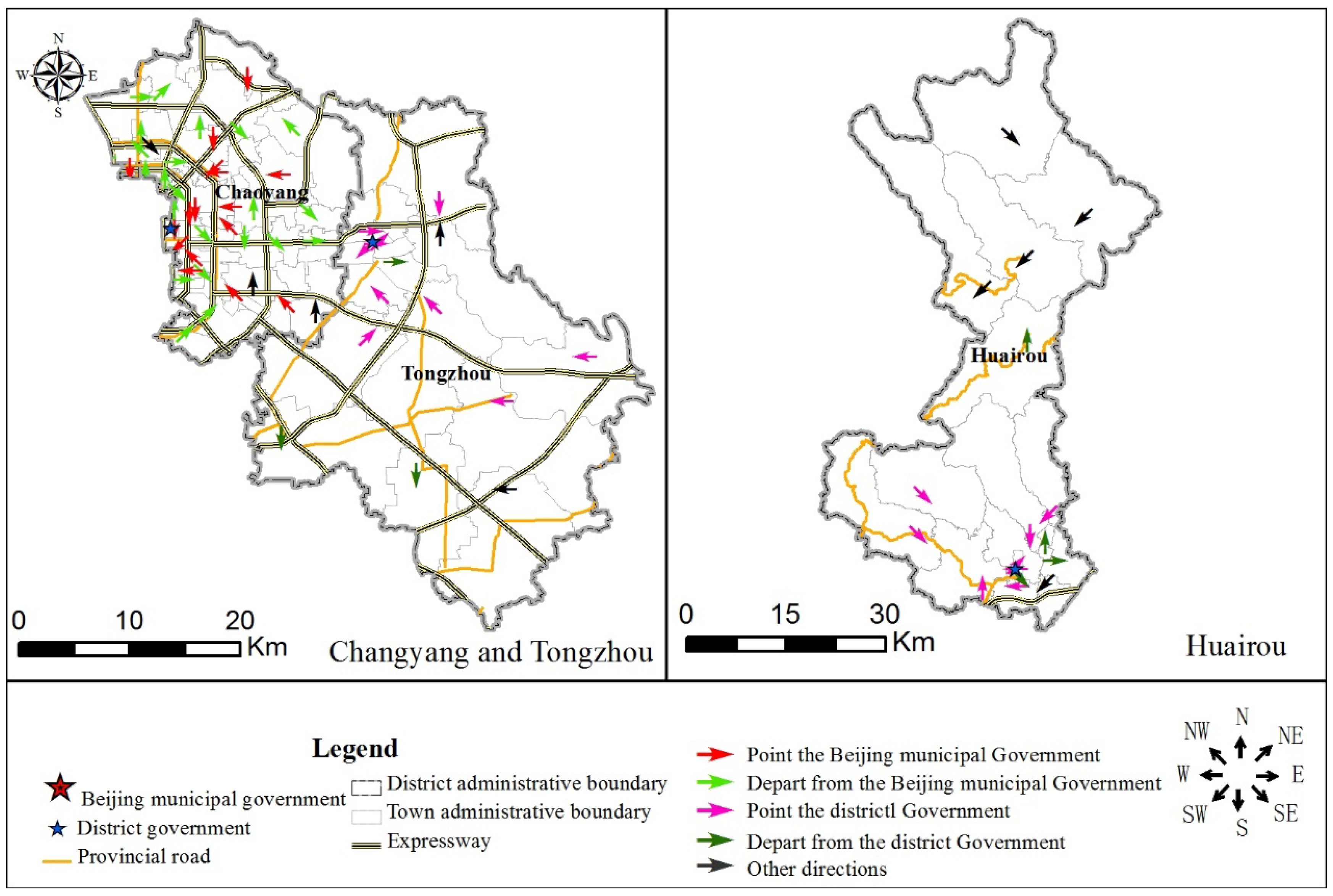
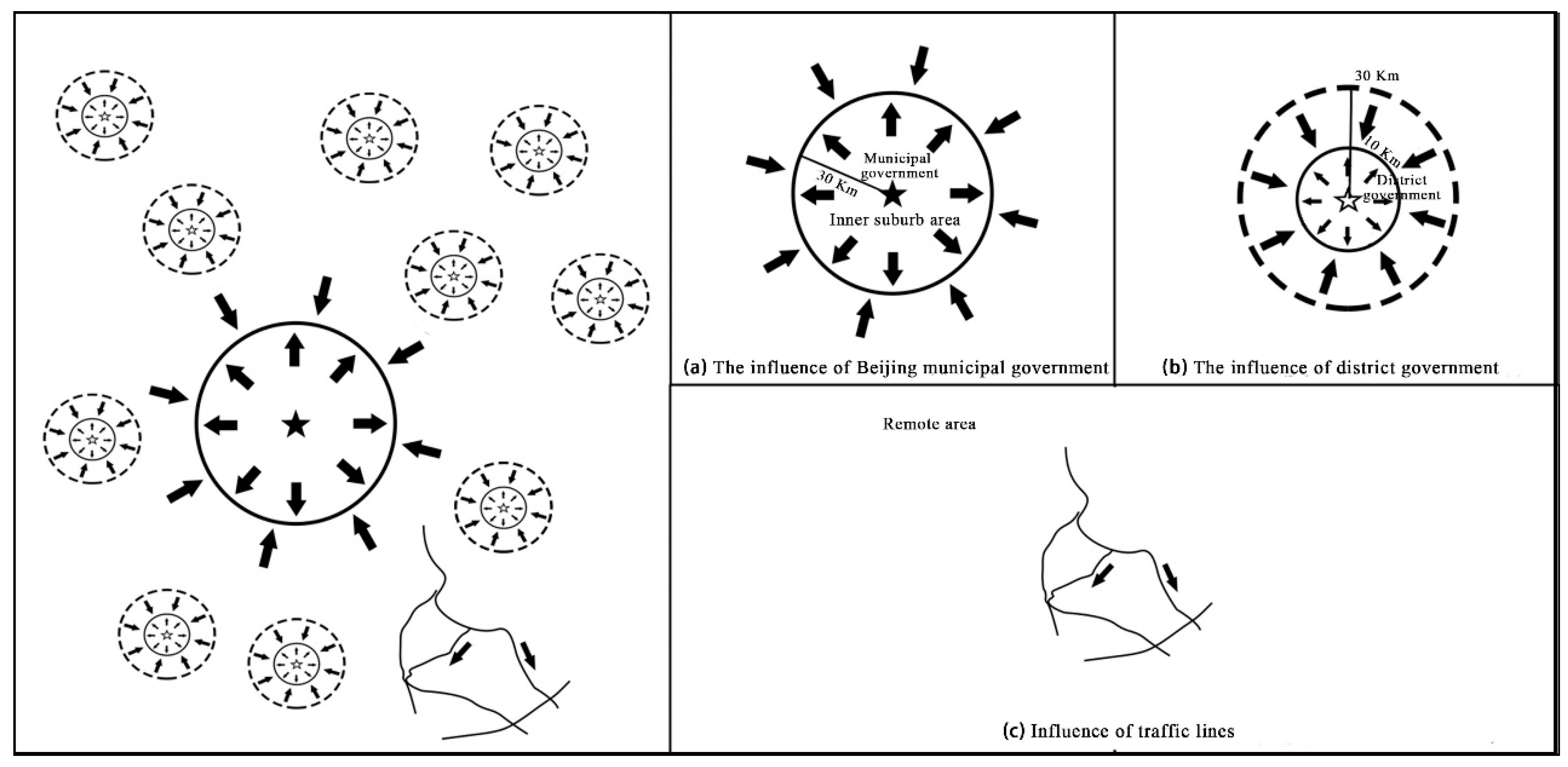
| Item | 1996 | 2003 | 2010 |
|---|---|---|---|
| Construction land area (km2) | 1993.7 | 2507.5 | 3080.4 |
| Share of total land area (%) | 12.2% | 15.3% | 18.8% |
| Buffer Regions | Area (km2) | Urban Land Area (km2) | Growth (km2) | Growth Rate (%) | ||||||
|---|---|---|---|---|---|---|---|---|---|---|
| 1996 | 2003 | 2010 | 1996–2003 | 2003–2010 | 1996–2010 | 1996–2003 | 2003–2010 | 1996–2010 | ||
| 0–10 km | 314.2 | 263.9 | 280.4 | 300.9 | 16.5 | 20.5 | 37.0 | 6.3 | 7.3 | 14.0 |
| 10–20 km | 942.5 | 367.0 | 497.8 | 702.3 | 130.8 | 204.5 | 335.3 | 35.6 | 41.1 | 91.4 |
| 20–30 km | 1570.8 | 346.1 | 485.9 | 696.8 | 139.8 | 210.9 | 350.7 | 40.4 | 43.4 | 101.3 |
| 30–40 km | 2010.9 | 338.4 | 437.5 | 493.8 | 99.1 | 56.3 | 155.4 | 29.3 | 12.9 | 45.9 |
| 40–50 km | 2028.3 | 276.0 | 316.8 | 329.2 | 40.8 | 12.4 | 53.2 | 14.8 | 3.9 | 19.3 |
| 50–60 km | 1893.5 | 124.9 | 149.2 | 162.7 | 24.3 | 13.5 | 37.8 | 19.5 | 9.0 | 30.3 |
| 60–70 km | 2017.8 | 137.2 | 166.3 | 195.3 | 29.1 | 29.0 | 58.1 | 21.2 | 17.4 | 42.3 |
| 70–80 km | 1998.5 | 86.6 | 105.5 | 120.5 | 18.9 | 15.0 | 33.9 | 21.8 | 14.2 | 39.1 |
| 80–90 km | 1566.3 | 26.2 | 31.5 | 37.2 | 5.3 | 5.7 | 11.0 | 20.2 | 18.1 | 42.0 |
| 90–100 km | 898.0 | 13.9 | 21.4 | 24.5 | 7.5 | 3.1 | 10.6 | 54.0 | 14.5 | 76.3 |
| 100–110 km | 690.9 | 9.1 | 10.7 | 12.2 | 1.6 | 1.5 | 3.1 | 17.6 | 14.0 | 34.1 |
| 110–120 km | 377.2 | 3.8 | 4.0 | 4.2 | 0.2 | 0.2 | 0.4 | 5.3 | 5.0 | 10.5 |
| 120–130 km | 92.5 | 0.5 | 0.5 | 0.8 | 0.0 | 0.3 | 0.3 | 0.0 | 60.0 | 60.0 |
© 2020 by the authors. Licensee MDPI, Basel, Switzerland. This article is an open access article distributed under the terms and conditions of the Creative Commons Attribution (CC BY) license (http://creativecommons.org/licenses/by/4.0/).
Share and Cite
Huang, D.; Tan, X.; Liu, T.; Chu, E.; Kong, F. Effects of Hierarchical City Centers on the Intensity and Direction of Urban Land Expansion: A Case Study of Beijing. Land 2020, 9, 312. https://doi.org/10.3390/land9090312
Huang D, Tan X, Liu T, Chu E, Kong F. Effects of Hierarchical City Centers on the Intensity and Direction of Urban Land Expansion: A Case Study of Beijing. Land. 2020; 9(9):312. https://doi.org/10.3390/land9090312
Chicago/Turabian StyleHuang, Daquan, Xin Tan, Tao Liu, Erxuan Chu, and Fanhao Kong. 2020. "Effects of Hierarchical City Centers on the Intensity and Direction of Urban Land Expansion: A Case Study of Beijing" Land 9, no. 9: 312. https://doi.org/10.3390/land9090312
APA StyleHuang, D., Tan, X., Liu, T., Chu, E., & Kong, F. (2020). Effects of Hierarchical City Centers on the Intensity and Direction of Urban Land Expansion: A Case Study of Beijing. Land, 9(9), 312. https://doi.org/10.3390/land9090312






